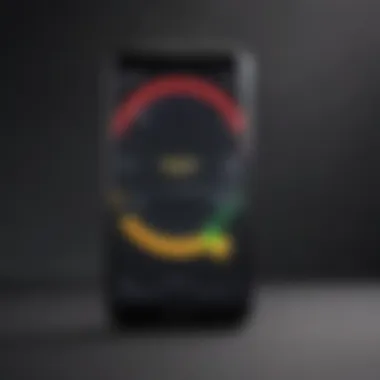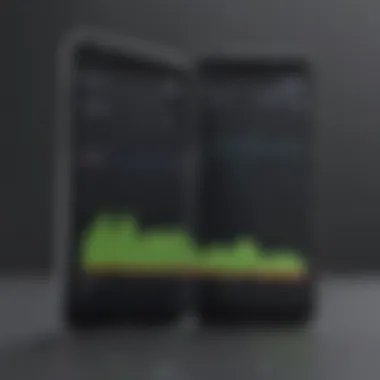Evaluating Android Phones for Optimal Battery Life


Intro
In today's fast-paced world, battery life stands as one of the primary concerns for smartphone users. The need for devices that can endure through the day without frequent recharging is critical. As Android phones continue to evolve, understanding how battery performance varies among different models is essential for consumers seeking optimal longevity. This article will explore several dimensions of Android smartphone battery life, from technical specifications to user experiences. Each segment aims to provide insights that will guide your decision when selecting an Android phone known for its impressive battery efficiency.
Overview of the Smartphone
Smartphone Foreword
When examining Android smartphones, one must recognize the multitude of choices available. Several manufacturers offer an array of models that cater to diverse user needs and preferences. The landscape is not only vast but also evolving, with each new release promising improvements in various dimensions, including battery performance.
Key Features and Specifications
Focusing specifically on battery life, it's crucial to consider several specifications:
- Battery Capacity: Measured in milliamp hours (mAh), this figure often gives an initial idea of longevity. However, a higher mAh doesn't always equate to better performance.
- Processor Efficiency: Modern processors like the Qualcomm Snapdragon series include features that optimize battery consumption.
- Display Technology: OLED displays tend to be more power-efficient compared to traditional LCDs, particularly in darker modes.
- Software Optimization: The operating system's efficiency plays a vital role in battery consumption, affecting overall user experience.
Pricing and Availability
Android phones with optimal battery life can range widely in price. Premium models often feature advanced technology that helps extend battery life, but there are also budget options that perform well. Knowing where to find these devices is key. Popular retailers, both online and offline, frequently carry a balanced selection of models.
By understanding the key features and specifications related to battery life, users are better equipped to make informed choices in their quest for an Android phone that meets their needs.
Intro to Battery Life in Android Phones
Battery life is one of the fundamental aspects that smartphone users consider when choosing an Android device. In a world where smartphones have become an essential part of daily life, understanding battery life is crucial. No one wants to be caught with a dead phone when an important task is at hand. Thus, knowing how long your device can last without being charged is not just a convenience but often a necessity.
Android phones are diverse. The market offers various models, each with different battery capacities and technologies. However, the battery performance can differ significantly based on multiple factors. This makes evaluating battery life a complex yet important task.
Additionally, advances in technology bring new features that add to battery drain. Knowledge about how these features affect battery performance can empower users to make informed decisions. By grasping the nuances of battery technology, users can select models that not only fit their needs but also offer longevity that suits their lifestyle.
Key Considerations:
- Battery Chemistry: Understanding the type of battery used can lead to better performance and lifespan.
- Software Optimization: Effective management of applications and services can prevent unnecessary battery drain.
- User Behavior: Daily habits impact how long a phone lasts on a single charge.
"An informed choice on battery capacity can lead to a more satisfying user experience in everyday life."
Understanding Battery Technology
Understanding battery technology is crucial for evaluating Android phones, especially when considering their optimal battery life. The type of battery, its capacity, and how it performs under different conditions directly impact how long a device can run on a single charge. Knowledge in this area helps users make informed decisions when selecting a smartphone.
Lithium-ion Battery Fundamentals
Lithium-ion (Li-ion) batteries are the standard for Android devices today. They offer several advantages that enhance user experience. First, they have a high energy density, meaning more energy can be stored in a lighter package. This trait helps manufacturers create thin and lightweight phones without compromising battery life.
Li-ion batteries also have a low self-discharge rate, retaining their charge for longer when not in use. However, they do have limitations. For instance, their lifespan decreases with excessive charging cycles and operating at high temperatures. Therefore, understanding these characteristics aids in optimizing both usage and longevity.
Battery Capacity Explained
Battery capacity is measured in milliamp hours (mAh). It indicates how much energy a battery can store. A higher mAh usually equates to longer usage between charges. For example, a battery with 4000 mAh can sustain operations longer than a 3000 mAh battery under similar conditions.
However, capacity alone doesn't determine battery life. Efficiency of the components and software also plays a significant role. Two phones with the same battery capacity may perform differently depending on how they manage power consumption and how their features are optimized.
Factors Affecting Battery Performance
Many factors can impact the performance of a battery in Android phones. These include:
- Screen Brightness: High brightness levels consume more power. Adjusting settings can significantly extend battery life.
- Background Applications: Apps running in the background can drain the battery unnecessarily.
- Network Connectivity: Using mobile data or a weak Wi-Fi signal causes the battery to work harder.
In analyzing these factors, it becomes clear that understanding battery technology is not just about how batteries work, but also involves knowing how user behavior and device features interplay to affect overall battery life.
"Battery technology is a key factor determining the usability and satisfaction of smartphone users."
By grasping these elements, users can better evaluate different Android models for their efficiency in battery life.


Significant Contributors to Battery Drain
Understanding the factors that contribute to battery drain in Android phones is crucial for users who prioritize battery life. As smartphones become more powerful and feature-rich, the demand for energy-efficient performance grows. By identifying the significant contributors to battery drain, users can make informed decisions to optimize their device's performance. This section presents a detailed evaluation of the elements that affect battery consumption, helping readers to minimize unnecessary energy use and extend their device’s longevity.
Screen Brightness and Usage
Screen brightness plays a pivotal role in determining battery life. Higher brightness settings can greatly increase battery drains. Bright displays utilize more power to illuminate the screen, especially when used for prolonged periods. Users can manage battery use by adjusting brightness settings to a lower level or enabling adaptive brightness, which automatically adjusts based on ambient light conditions.
Specific suggestions include:
- Use manual brightness adjustment wisely.
- Avoid maximum brightness unless necessary.
- Consider dark mode settings, which can help save battery on OLED screens.
Monitoring your usage patterns is equally important. Activities such as gaming or video streaming require higher brightness and tend to drain the battery more rapidly. Being mindful of how you interact with your device can lead to more prudent energy consumption.
Background Applications and Processes
Another significant contributor to battery drain comes from background applications. Many apps run processes even when they are not actively in use, consuming resources. Social media, weather, and messaging applications often refresh data in the background, leading to unexpected energy draws.
To combat this issue, users should regularly review app settings. Some strategies include:
- Disable background data for less critical applications.
- Close apps when not in use instead of leaving them running.
- Use battery optimization features within the device settings to restrict background activity.
This conscious attention toward managing applications can result in noticeable improvements in battery lifespan.
Network Connectivity Factors
Network connectivity plays a crucial role in battery life. Constantly searching for Wi-Fi signals or mobile networks can lead to increased battery drain. The device expends energy maintaining connections, particularly in low-signal areas.
To enhance battery efficiency related to connectivity, users should:
- Turn off mobile data or Wi-Fi when not in use.
- Avoid using location services unless necessary.
- Switch to airplane mode during extended periods without service.
By modifying these connectivity settings, users can significantly lessen battery drain and ensure their device remains operational for longer periods.
In summary, the interplay of screen brightness, background applications, and network factors profoundly impacts the overall battery life of Android devices. By being aware of these contributors, users can take actionable steps to improve energy efficiency.
The Role of Software Optimization
Software optimization plays a crucial role in enhancing the battery life of Android phones. It encompasses a variety of practices that improve the efficiency of hardware usage, allowing users to get the most out of their devices. Optimized software means that the operating system and applications run smoothly and use minimal resources, which directly influences the longevity of the battery.
A well-optimized system can significantly reduce unnecessary power consumption. This is important not only for extending battery life but also for improving users' overall experiences with their devices. Manufacturers often prioritize this aspect, aiming to deliver devices that work efficiently without frustrating battery drain.
Good optimization strategies are evident in the following key areas:
- Responsiveness of the operating system
- Efficient resource management
- Smart application updates that minimize power usage
The benefits of effective software optimization cannot be overlooked. It encourages longer usage times between charges and maintains performance levels without compromising functionality. So, let's examine the components that contribute to effective optimization more closely.
Operating System Efficiency
Operating system efficiency is fundamental to Android phones. Manufacturers like Google with its Android OS frequently update system features and security to ensure optimal performance. Efficient operating systems manage processes smartly, allocating resources to essential applications while limiting background activity.
An optimized OS improves multitasking capabilities, resulting in better battery utilization. For instance, Android versions regularly adapt to individual usage patterns, allowing less used apps to enter a sleep mode when not in use. Moreover, some models utilize Ultra Power Saving modes, effectively disabling most apps to elongate battery life.
Battery Management Systems
Battery management systems (BMS) are critical for monitoring and optimizing how battery power is used within devices. This system ensures that the battery operates within safe parameters and facilitates optimal charging and discharging cycles.
BMS technology has a few core functions, including:
- Regulating voltage levels to prevent overcharging.
- Reducing power drain by managing device workloads.
- Extending battery lifespan through smart charge cycles.
Advanced BMS also analyze historical usage data, allowing for predictive power management. This means users can benefit from better efficiency based on their personalized usage habits.


Updates and Their Impact
Software updates significantly impact battery life and performance. When manufacturers release updates, they often include enhancements that improve battery optimization not only in the operating system but also in apps. These updates can fix bugs that cause excessive battery drain, therefore prolonging overall battery health.
Furthermore, updates bring new features aimed at efficiency. They may introduce options like adaptive battery settings, which learn user habits and prioritize power for frequently used apps. Regular updates ensure devices leverage the latest technologies in power management and usage efficiency.
"Properly optimized software can maximize battery performance and ensure that a device serves its user until the end of the day,"
As avid smartphone users and tech enthusiasts, understanding the role of software optimization can not only aid in selecting better devices, but also in making informed decisions about how to extend battery life beyond the manufacturer's specifications.
Comparative Analysis of Current Models
In the context of Android smartphones, conducting a comparative analysis of current models is vital. This approach allows users to assess performance based on battery life, ensuring their investment aligns with personal or professional needs. Evaluating various models provides insights into how different manufacturers prioritize battery technology and user satisfaction, influencing choices in an oversaturated market.
When examining multiple devices, consider several key elements:
- Battery capacity: Measured in milliampere-hours (mAh), this figure indicates the potential longevity of the phone under standard usage.
- Efficiency of software: Some manufacturers integrate optimized software to minimize battery drain, extending usability time.
- Charging speed: Quick charging abilities can provide convenience for users with active lifestyles.
Therefore, a comparative analysis can lead to informed decisions, ensuring users find a smartphone that offers optimal battery performance.
Flagship Phones with High Battery Capacity
Flagship devices typically showcase innovative features and high battery capacity. Models like the Samsung Galaxy S23 Ultra and OnePlus 11 are notable examples. These smartphones usually feature batteries over 5000 mAh, capable of lasting through extensive usage.
These phones often come equipped with advanced displays that, while power-hungry, function efficiently due to adaptive refresh rates. This means the phone can adjust display performance based on usage, ensuring a balance between visual quality and battery preservation.
Additionally, Fast charging technology can recharge the battery significantly, often up to 50% in just 30 minutes. Users find that these features, combined with high capacities, result in a pleasant experience, permitting extended usage without frequent recharging.
Mid-range Options for Longevity
Mid-range smartphones are increasingly prioritizing battery longevity to attract users. Devices like the Google Pixel 7a and Samsung Galaxy A54 stand out with batteries that can last a full day under normal conditions.
These models strike a balance between cost-effective performance and impressive battery life. Their battery capacities generally range from 4000 mAh to 5000 mAh, making them suitable for users who need functionality without the flagship price tag.
Moreover, many mid-range devices incorporate software efficiencies similar to those found in their flagship counterparts. This allows them to compete effectively, offering features that help prolong battery use, such as adaptive brightness and app management.
Budget Phones with Impressive Battery Life
For those who are budget-conscious, several models offer substantial battery life without sacrificing performance. Devices like the Moto G Power series are specifically designed to maximize battery efficiency. The Moto G Power (2023), for instance, boasts a 5000 mAh battery designed to last up to three consecutive days with moderate use.
Budget smartphones generally offer lower performance specs in other areas but focus on delivering maximum uptime, making them ideal for users who primarily need a phone for calls, texts, and occasional app use. Many of these devices also reduce display resolutions and less demanding hardware to conserve energy, ensuring the overall longevity of their battery life.
In summary, understanding the segment of the market helps consumers to make wise choices tailored to their needs. As the demand for reliable smartphone battery life continues to rise, evaluating models based on these criteria becomes even more important.
User Behavior and Battery Life
Understanding the relationship between user behavior and battery life in Android devices offers essential insights for optimizing smartphone performance. Users play a significant role in how efficiently a device utilizes power. Battery life can be adversely affected by habits, choices, and settings. With varying daily usage patterns, each person's interaction with their device can lead to notable differences in battery performance. Whether you're a heavy usage gamer, a casual social media scroller, or a business professional checking emails periodically, grasping how these elements influence energy consumption is crucial.
Daily Usage Patterns
Daily usage patterns refer to how often and for what purposes a user engages with their smartphone. A user who frequently streams videos or plays demanding games will notice shorter battery life compared to one who mainly uses their phone for calls and messaging. This variance creates different tiers of battery efficiency.
- Screen On Time: The amount of time the screen stays active greatly impacts battery usage. More screen time equals more energy consumption.
- Application Usage: Some applications require more resources. High-performance apps, such as navigation or gaming apps, increase battery drain significantly.
- Task Frequency: Redundant tasks, like checking notifications excessively, can add to daily usage and affect battery life.
To optimize battery performance, users should track their daily usage. Understanding which activities consume more energy can help in managing and adjusting habits accordingly.
Settings Adjustments for Longevity
Settings adjustments can greatly enhance battery longevity. Simple tweaks in your device’s settings can yield significant improvements in how long the battery lasts throughout the day.
- Brightness Level: Lowering the screen brightness or enabling adaptive brightness can help save battery. High brightness levels quickly drain battery life.
- Location Services: Turning off GPS and location services when not in use can preserve power. Frequent location checking consumes a large amount of energy.
- Background Data Usage: Limiting background data for applications also helps. Many apps continue to refresh content even when not open, leading to battery drain.
By being proactive in adjusting settings, users can establish healthier habits that contribute to longer battery life.


Power-Saving Modes and Their Effectiveness
Power-saving modes are built-in features in many Android devices designed to limit battery consumption. These modes often reduce background activity, lower screen brightness, and restrict certain applications from using data. Their effectiveness varies by device and user habits.
Effective use of power-saving modes can extend battery lifespan significantly during critical times, such as when a charger is not available.
- Standard Power-Saving Mode: This mode conserves battery by limiting performance and restricting background data. It is useful for everyday situations but may affect app performance.
- Extreme Power-Saving Mode: This mode often permits only essential functionalities, like calls and texts. It is beneficial for emergencies when the battery is critically low.
Considering these modes judiciously allows users to maintain control over their device's battery health. Implementing power-saving features aligns with responsible smartphone usage, leading to a more enjoyable experience without the frustration of running out of power when one needs it the most.
Real-World Testing Results
Evaluating battery life in Android phones goes beyond specifications. Real-world testing results provide a deeper understanding of how these devices perform under normal usage conditions. It reflects the practical experience of users, which is crucial in selecting a phone that truly meets battery longevity expectations. Following benchmarks and thorough evaluations can unveil discrepancies between advertised and actual performance, aiding consumers in making informed decisions.
Battery Endurance Benchmarks
Battery endurance benchmarks measure how long a phone's battery lasts under controlled conditions. Tests commonly assess elements like screen-on time, video playback, gaming, and browsing. For instance, GSMArena frequently provides detailed report on battery endurance ratings for various models.
Often, flagship models like the Samsung Galaxy S21 Ultra or the Google Pixel 6 Pro exhibit impressive endurance, lasting long through intensive tasks. However, mid-range devices, such as the OnePlus Nord and Xiaomi Redmi Note, can surprise users with their efficiency, sometimes outperforming their pricier counterparts in real-world settings.
By relying on reputable benchmarks, buyers can gain clear insights into expected battery performance. It’s also essential to check for consistency among different testing sites, as methods can vary.
User Feedback and Experience
User feedback plays a significant role in assessing battery life. While technical specifications provide a starting point, the real-world experiences of users shed light on practical aspects such as the phone's overall optimization, screen usage, and daily challenges encountered. Forums like Reddit and user reviews on Facebook present valuable anecdotes that can reveal hidden problems.
Many users report that while a phone may show strong battery capacity on paper, software optimizations and updates can create disparities in real-life performance. For example, Samsung's One UI has been frequently praised for its effective battery management, which contributes to longer life in daily use.
Conversely, devices may also face criticism if they drain faster than expected due to bugs or mismanagement in software. Integrated feedback allows potential buyers to weigh their options carefully, leading to a better understanding of how a model performs in everyday scenarios.
"User experience is indispensable; it bridges the gap between technical specifications and actual battery performance."
Future Trends in Battery Technology
In today's technology landscape, battery life is a crucial aspect of Android smartphones. As smartphones become integral to daily life, understanding future trends in battery technology can help users make informed decisions. Enhancements in battery technology not only improve device longevity but also contribute to better user experiences and environmental sustainability.
Advancements in Battery Chemistry
The future of battery technology is heavily rooted in chemistry. Traditional lithium-ion batteries have been dominant, yet researchers explore alternatives that offer higher energy densities and faster charging capabilities. Emerging technologies, such as solid-state batteries, utilize solid electrolytes, potentially leading to batteries that are safer and have more capacity.
Solid-state batteries could reduce the risk of overheating, a significant concern with current lithium-ion models. Furthermore, advancements in battery chemistry may yield batteries that charge faster while lasting longer, a win-win for users needing performance.
Fast Charging Developments
Fast charging technology is rapidly evolving. Users today demand quick solutions, making this aspect vital for manufacturers. Recent innovations like Warp Charge by OnePlus and SuperCharge from Huawei showcase how brands are pushing the boundaries of charging speeds, allowing batteries to reach significant charges in minimal time.
Fast charging does not come without its challenges. Safety measures must keep pace with speed enhancements. Manufacturers must ensure that fast charging does not negatively impact battery health over time. Thus, achieving an equilibrium between speed and longevity is crucial.
Sustainability and Battery Lifecycle
Sustainability is becoming increasingly important in the conversation surrounding battery technology. The environmental impact of battery production and disposal cannot be ignored. As electric vehicles and smartphones continue to proliferate, sustainable practices must be integrated into battery manufacturing.
Developments in recycling technologies and the use of materials such as lithium from sustainable sources will matter in the long run. This shift aims to minimize the environmental footprint of battery production processes. Lifecycle management practices will also play a critical role in recycling old batteries and repurposing materials effectively.
"Adopting sustainable practices in battery production is not just beneficial; it's essential for a greener future."
In summary, future trends in battery technology signify a dedication to improving not just performance but also sustainability. As advancements unfold, they hold great promise for avid smartphone users and tech enthusiasts seeking longevity and efficiency in their devices.
Culmination
In this exploration of battery life in Android phones, it is critical to understand the multifaceted elements influencing performance. Optimal battery life is not solely a matter of having a large-capacity battery. There are several other aspects to consider when selecting a device. Factors like software optimization and user behavior can have a pronounced effect on a phone's battery endurance.
Understanding the nuances discussed in this article equips potential buyers with essential tools to make informed decisions. For instance, recognizing how different applications consume power can guide users toward adjusting their habits.
Additionally, it is important to consider models that incorporate advanced battery management systems. Phones by brands like Samsung and Google exemplify this, often enhancing the longevity of their devices.
In the realm of battery technology, developments in fast charging and chemistries can change the landscape for users. As innovation continues, devices are likely to emerge that can provide even better efficiency and sustainability.
"Battery life is not just a specification; it's a crucial part of user experience."
Ultimately, when opting for an Android phone, it is advisable to weigh specifications against personal usage patterns. This approach ensures that the selected model aligns with individual needs, thus maximizing usability and satisfaction. Evolving technologies will continue to influence battery performance, making it ever more relevant to engage in such evaluations.



